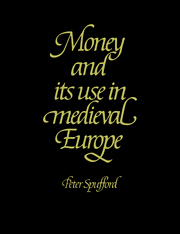Book contents
- Frontmatter
- Contents
- List of maps
- List of tables
- List of graphs
- Acknowledgements
- Introduction
- Part I Before the Commercial Revolution
- Part II The Commercial Revolution of the Thirteenth Century
- 5 New Silver c. 1160 – c. 1330
- 6 The Balance of Payments and the Movement of Silver
- 7 European Silver and African Gold
- 8 New Mints
- 9 Ingots of Silver
- 10 New Money
- 11 The Place of Money in the Commercial Revolution of the Thirteenth Century
- Part III The Late Middle Ages
- Conclusion
- Appendix I The Coins Most Commonly in Use in the Middle Ages
- Appendix II Money of Account
- Appendix III Production at Some Later Medieval Mints
- Bibliography
- Coin Index
- General Index
- Frontmatter
- Contents
- List of maps
- List of tables
- List of graphs
- Acknowledgements
- Introduction
- Part I Before the Commercial Revolution
- Part II The Commercial Revolution of the Thirteenth Century
- 5 New Silver c. 1160 – c. 1330
- 6 The Balance of Payments and the Movement of Silver
- 7 European Silver and African Gold
- 8 New Mints
- 9 Ingots of Silver
- 10 New Money
- 11 The Place of Money in the Commercial Revolution of the Thirteenth Century
- Part III The Late Middle Ages
- Conclusion
- Appendix I The Coins Most Commonly in Use in the Middle Ages
- Appendix II Money of Account
- Appendix III Production at Some Later Medieval Mints
- Bibliography
- Coin Index
- General Index
Summary
A great increase in the amount minted was the most obvious consequence of the vast quantities of new silver being mined in Europe from the 1160s onwards. Although large amounts of silver did circulate in uncoined bars, even larger quantities were turned into coin year by year until the 1320s. As more and more silver was carried about Europe, there was an ever greater need in all parts of the continent to turn uncoined silver into coined silver, foreign coin into local coin and, every so often, old coin into new coin.
At first this meant a reopening of mints that had been closed, and an increase in the activity of those that had remained open. It also entailed the opening of more and more mints to cope with the demand for coin to be easily available everywhere. However, after a certain point had been reached, it became more practical to manage the increasing quantity of coinage by using fewer, larger mints rather than more and more tiny, local mints. In other words, the initial stages of the expansion merely resulted in more of the same sort of small, workshop mint that had been inherited from the ‘Viking’ and ‘feudal’ period. However, the later stages of the expansion resulted in the creation of minting ‘factories’ involving considerable division of labour, with hundreds of workmen, run for rulers by profit- and costconscious entrepreneurs, often Tuscans, who treated them as large-scale business ventures.
- Type
- Chapter
- Information
- Money and its Use in Medieval Europe , pp. 187 - 208Publisher: Cambridge University PressPrint publication year: 1988



